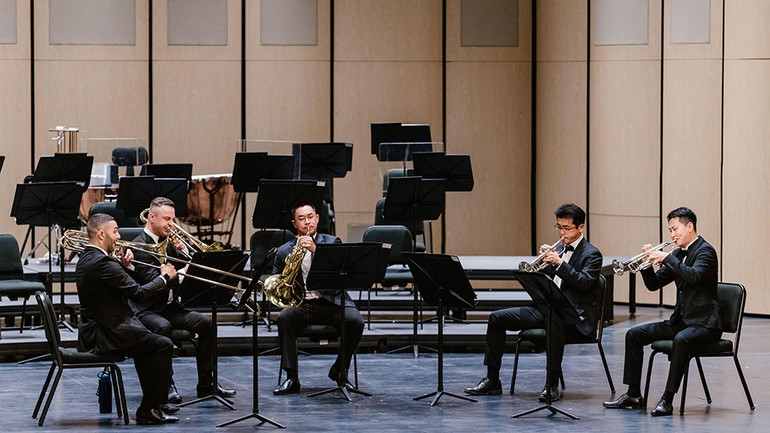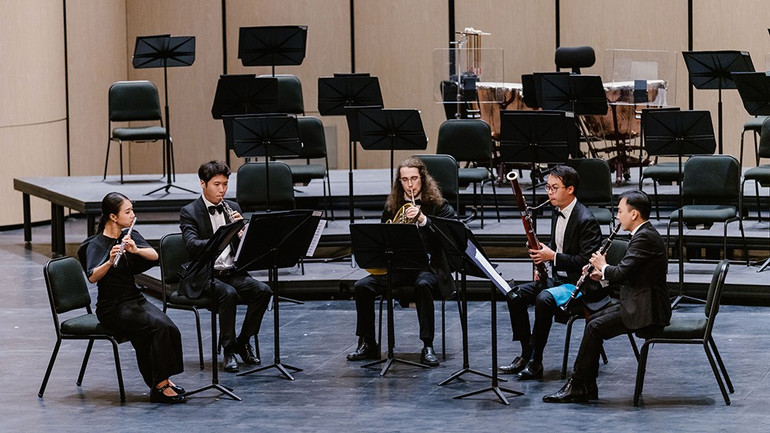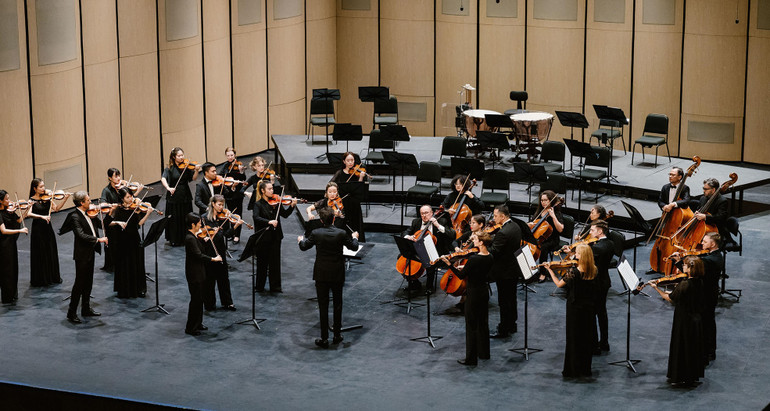
In a letter to his sister Fanny, he excitedly shared: “This country is always filled with a festive atmosphere, it gives me a very fresh and intense feeling. The Italian symphony is progressing very quickly, it will be the happiest work I have ever composed, especially the last movement”.
Nearly two centuries later, Symphony No. 4 in A major, Op.90 - "the most joyful work" in the vast compositional legacy that Mendelssohn - "the most typical representative of the Romantic school" left for posterity - was emotionally conveyed to the audience of the Capital, in a beautiful musical journey called "As One: An Orchestral Journey" by the Sun Symphony Orchestra.
When "musical families" show off their voices together
Symphony music is like a multi-colored painting, where each group of instruments has its own distinct personality but blends together to create a perfect whole. In English, each set of instruments is called an “instrument family”. Like each individual member of a family, each instrument has its own personality: energetic percussion, graceful woodwinds and soft strings, powerful brass. All come together, blending together to create performances that touch the hearts of music lovers.
In this performance titled As One: An Orchestral Journey, with the intelligent and witty guidance of the French conductor, the audience will meet each “family” through each piece written specifically for the instrument before blending together into a harmonious whole in Mendelssohn’s Symphony No. 4 - a picture of the Mediterranean filled with sunshine, festive colors and a spirit of community.

It can be said that this is a rare night where conductor Olivier Ochanine is so “leisurely”. He only had to wave his baton once, in a beautiful work like a poem by Italian composer Ottorino Respighi. The audience in the auditorium was very surprised when the Italian symphony with the combined strength of the four “families of instruments” mentioned above was performed very well without the need for coordination from the orchestra conductor.
Instead of holding the “inseparable” baton, he sang along with the flute in the center of the orchestra and pleasantly surprised the audience. That is also the typical style of this conductor, when he always researches and brings a strange, “unique” mark to each SSO concert.

The concert opened with Gene Koshinski’s As One, a powerful, precise and dramatic dialogue between the two drummers that felt like the music’s primal heartbeat. From there, the five musicians rose to full force and verve through Brass Quintet No. 1 – Victor Ewald’s first classic for brass quintet, both proud and tender.

The woodwind quintet brings mischief, grace and wit to Trois pièces brèves, where composer Jacques Ibert breathes 1930s Paris into three concise yet humorous and elegant musical pieces.

The strings, the most numerous and also the most familiar, took the audience back to Renaissance Italy through Ottorino Respighi's Ancient Airs and Dances Suite No. 3 - where classical melodies were revived in a soft and lyrical waterfall of sound.
And make a symphony filled with happiness
Felix Mendelssohn went down in history as a musical prodigy, an excellent pianist, a great composer, a talented conductor and also a master critic. His talent was revealed very early, when in just 4 years (from the age of 11 to 15), the young boy consecutively produced 13 symphonies for strings and Symphony No. 1 in C minor, Op.11.
At the age of 17, Mendelssohn's Overture to A Midsummer Night's Dream Op.21 amazed European classical music lovers. "A work that can make any musician respect. Although inheriting the classical tradition, the author possesses a romantic soul. This is not an invisible world built by imagination but a real world inspired by dreams" is the compliment that the genius composer F. Chopin gave to the young man.
In October 1830, the 21-year-old composer crossed the Alps into Italy, exploring a country that he had a premonition of “being the most wonderful trip of my life.” The grandeur of ancient Roman culture still imprinted in Rome, the great architectural works and famous Renaissance paintings and sculptures in Florence, and the peaceful countryside of Naples in Southern Italy fascinated and captivated him in a very special way.
The ten months spent in this boot-shaped country brought the musician abundant inspiration, allowing him to have the most sublime period in his composing career. Five cantatas, Concerto No. 1 for piano and orchestra in G minor, Op. 25 were born during this short time. And of course, we cannot forget Italian - the Italian Symphony No. 4 in A major, Op. 90. It is a bright picture of Italy through the eyes of Northern European romanticism, with musical movements full of vitality, color and characteristic rhythm, helping it to be chosen by conductor Olivier Ochanine as an unforgettable highlight in the latest repertoire of the Sun Symphony Orchestra.
The work consists of 4 musical movements with a format that is completely suitable for the standards of a symphony positioned by the names of Haydn-Mozart, vividly recreating a brilliant panorama of Italy filled with sunshine, bustling with pilgrimage steps and excitement with energetic folk dances. As a person with a kind heart and a soul close to nature, Mendelssohn's works are always poetic, rich in lyricism, graceful and passionate. The ranges of emotions are expressed perfectly, the melody is simple but extremely profound.
The first movement opens with the sound of woodwinds and pizzicato strings, which evoke the clear, blue sky of Italy, which made such a strong impression on Mendelssohn, who was so familiar with the gray, cloudy skies of the north that he once described the piece as “the blue sky in A major.”
The second movement, Andante con moto in D minor, features pizzicato strings and music reminiscent of footsteps, with a clearly religious musical theme through a somber melody of oboe, clarinet and viola.
Chapter III returns to a warm, cheerful atmosphere with a beautiful legato stroke from the strings and woodwinds. The final movement has a very clear Southern Italian folk sound, where the vineyards stretch endlessly, where beautiful country girls trample grapes with their feet during the day and move their feet to the lively folk music at night.
Many musicologists have tried to suggest interesting associations in each movement of the symphony. For example, the lively urban scene of Venice may be the subject of the first movement, the solemn Rome in the middle of Holy Week in the second movement, the elegant cathedrals and palaces of Florence displaying their splendor in the third movement or the lively folk dances of saltarello and tarantella of Naples in the fourth movement.
But although the image that the music evokes in the mind of each listener will be different, for each audience member present at the Hoan Kiem Theater on the evening of September 25, the joyful sound and happy colors of Symphony No. 4 certainly brought unforgettable emotions and a great love for Italy, through the synchronized heartbeats of a master musician.
On the journey of designing the repertoire for each performance, Conductor and Music Director Olivier Ochanine always carries out the dream of bringing classical music as close to the Vietnamese public as possible. From popular educational programs to chamber music nights that he has persistently carried out since the early days of founding SSO, many generations of listeners - especially the young generation - will have basic knowledge from low to high, access to a variety of works - authors from familiar to unfamiliar so that they can gradually understand and love the academic music genre that is always considered very selective of audiences. As One: An Orchestral Journey is such a bright spot, in the flow of establishing new audiences for classical music in the future.
Source: https://nhandan.vn/nuoc-y-diem-den-cua-chuyen-du-hanh-am-nhac-post910984.html



![[Photo] The 4th meeting of the Inter-Parliamentary Cooperation Committee between the National Assembly of Vietnam and the State Duma of Russia](https://vphoto.vietnam.vn/thumb/1200x675/vietnam/resource/IMAGE/2025/9/28/9f9e84a38675449aa9c08b391e153183)
![[Photo] Joy on the new Phong Chau bridge](https://vphoto.vietnam.vn/thumb/1200x675/vietnam/resource/IMAGE/2025/9/28/b00322b29c8043fbb8b6844fdd6c78ea)

![[Photo] National Assembly Chairman Tran Thanh Man presided over the welcoming ceremony for Chairman of the State Duma of the Russian Federation Vyacheslav Volodin](https://vphoto.vietnam.vn/thumb/1200x675/vietnam/resource/IMAGE/2025/9/28/889b54ac5cd440099ddc618c99663612)
![[Photo] High-ranking delegation of the Russian State Duma visits President Ho Chi Minh's Mausoleum](https://vphoto.vietnam.vn/thumb/1200x675/vietnam/resource/IMAGE/2025/9/28/c6dfd505d79b460a93752e48882e8f7e)












![[Photo] Joy on the new Phong Chau bridge](https://vphoto.vietnam.vn/thumb/402x226/vietnam/resource/IMAGE/2025/9/28/b00322b29c8043fbb8b6844fdd6c78ea)

![[Photo] The 4th meeting of the Inter-Parliamentary Cooperation Committee between the National Assembly of Vietnam and the State Duma of Russia](https://vphoto.vietnam.vn/thumb/402x226/vietnam/resource/IMAGE/2025/9/28/9f9e84a38675449aa9c08b391e153183)

![[Photo] High-ranking delegation of the Russian State Duma visits President Ho Chi Minh's Mausoleum](https://vphoto.vietnam.vn/thumb/402x226/vietnam/resource/IMAGE/2025/9/28/c6dfd505d79b460a93752e48882e8f7e)
![[Photo] National Assembly Chairman Tran Thanh Man presided over the welcoming ceremony for Chairman of the State Duma of the Russian Federation Vyacheslav Volodin](https://vphoto.vietnam.vn/thumb/402x226/vietnam/resource/IMAGE/2025/9/28/889b54ac5cd440099ddc618c99663612)































































Comment (0)